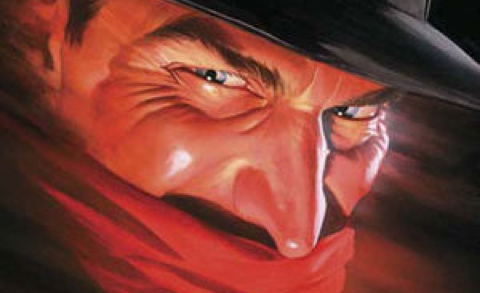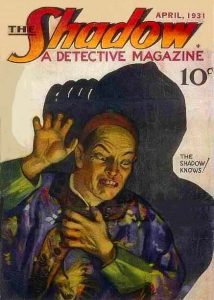 Pulp magazines have had a profound effect on popular culture across the globe. Their stories and art have reverberated through a wide variety of media — comic books, movies, paperbacks, genre fiction, television, men’s adventure magazines, radio drama, video, anime, manga, and role-playing games.
Pulp magazines have had a profound effect on popular culture across the globe. Their stories and art have reverberated through a wide variety of media — comic books, movies, paperbacks, genre fiction, television, men’s adventure magazines, radio drama, video, anime, manga, and role-playing games.
Continuing characters have always been with us. Homer told of Odysseus, prevented by the gods from returning to his home for ten years. Then there’s Alexandre Dumas’ d’Artagnan, introduced in THE THREE MUSKETEERS and its sequels. One of the most famous continuing characters is Sir Arthur Conan Doyle’s Sherlock Holmes. The private detective is the protagonist of sixty-two stories, originally published between 1887 and 1927. And don’t forget about such dime novel heroes as Buffalo Bill, Frank Merriwell, and Nick Carter. The latter debuted in 1886 and continued in varying formats for about a century. Many of his stories were published by Street & Smith, the company that would introduce the first single character pulp.
On March 6, 1931, THE SHADOW: A DETECTIVE MAGAZINE debuted on American newsstands. The first single character or hero pulp, it revived a fiction format that had disappeared with the demise of the dime novels and story papers. Author Walter B. Gibson refashioned The Shadow — the sinister narrator of CBS Radio’s THE DETECTIVE STORY HOUR — into the first pulp hero. Gibson’s character was a dark and mysterious crime-busting super-sleuth who embodied the iconic power of classic villains like Dracula. The Shadow served as the template for other hero pulps and, later, scores of comic book superheroes. Gibson and his occasional fill-in, Theodore Tinsley, also introduced the concept of super-crooks and super-crime.
Lasting 325 issues and spanning eighteen years, THE SHADOW pulp was cancelled in 1949. However, Gibson’s and Tinsley’s character had left his mark on popular culture. The Shadow would travel full circle to his beginnings and become a long-running radio program. The series premiered in late September 1937 over the Mutual Broadcasting System, featuring Orson Welles as the mystery man. Other actors would follow the famed actor and director in the role.
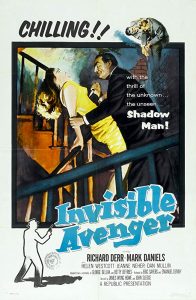 One month after The Shadow debuted on radio, the first of two movie serials appeared. THE SHADOW STRIKES starred Rod La Rocque and was based on a pulp novel by Walter Gibson. In 1946, Monogram Pictures released three Shadow movies starring Kane Richmond. 1958 would see Republic Pictures release INVISIBLE AVENGER, a theatrical film culled from two episodes of a pilot for a Shadow television series. Universal Pictures would release another Shadow film in 1994 starring Alec Baldwin as the title character.
One month after The Shadow debuted on radio, the first of two movie serials appeared. THE SHADOW STRIKES starred Rod La Rocque and was based on a pulp novel by Walter Gibson. In 1946, Monogram Pictures released three Shadow movies starring Kane Richmond. 1958 would see Republic Pictures release INVISIBLE AVENGER, a theatrical film culled from two episodes of a pilot for a Shadow television series. Universal Pictures would release another Shadow film in 1994 starring Alec Baldwin as the title character.
Concurrent to the original pulp series, The Shadow also began appearing in books. Street & Smith got the ball rolling with three hardcovers in their “Ideal Library.” First came THE LIVING SHADOW in 1932, reprinting the initial entry of the pulp series. Whitman Publishing followed with three “Better Little Books” featuring the character.
In 1941, LA Bantam published THE SHADOW AND THE VOICE OF MURDER, the first Shadow paperback. It was a reprint of a Walter B. Gibson pulp novel. Belmont Books began publishing brand new Shadow novels in 1963. Their first book — THE RETURN OF THE SHADOW — was written by Gibson. Over the next twenty years, other book publishers — Grosset & Dunlap, Bantam Books, Dover Books, the Doubleday Crime Club, and The Mysterious Press — would reprint the Shadow’s pulp adventures in various formats. The most successful was Pyramid Books (later Jove Books). From 1974 to 1978, the company reprinted twenty-three Shadow pulp novels, largely featuring cover art by James Steranko. The artist — a pulp collector himself — returned to the original pulps for his inspiration.
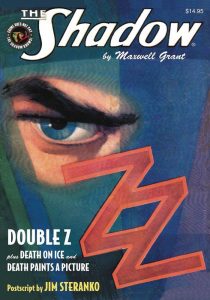 During the summer of 2006, Sanctum Books — originally in association with Nostalgia Ventures — began to reprint The Shadow’s pulp adventures as trade paperbacks. Their first volume featured Lester Dent’s “The Golden Vulture,” the author’s sole contribution to The Shadow series. To date, Sanctum Books has published nearly 300 of The Shadow’s original novels. Sanctum will be exhibiting at PulpFest 2019.
During the summer of 2006, Sanctum Books — originally in association with Nostalgia Ventures — began to reprint The Shadow’s pulp adventures as trade paperbacks. Their first volume featured Lester Dent’s “The Golden Vulture,” the author’s sole contribution to The Shadow series. To date, Sanctum Books has published nearly 300 of The Shadow’s original novels. Sanctum will be exhibiting at PulpFest 2019.
In addition to books, radio, and film, the Shadow has also made an indelible mark in the graphic format. While the Columbia Pictures movie serial of 1940 was still playing in theaters, Street & Smith premiered SHADOW COMICS. Doc Savage — another Street & Smith pulp hero — was also featured in the comic book’s early issues. SHADOW COMICS lasted until August 1949, running for a total of 101 issues. From 1940 – 1942, the character also appeared in a newspaper strip written by Walter Gibson and illustrated by Vernon Greene.
In 1964, Archie Comics premiered a new comic book series featuring the Street & Smith pulp hero. Although The Shadow wears his familiar cloak and slouch hat on the cover to the first issue, later numbers feature him in superhero garb. Interestingly, Jerry Siegel, one of the creators of Superman, wrote the final five numbers of the eight-issue series.
In the fall of 1973, DC Comics introduced perhaps the most highly regarded of all comic books featuring The Shadow. Created by Dennis O’Neil, the comic introduced artist Mike Kaluta’s version of The Dark Knight. Unfortunately, the DC comic book lasted a mere twelve issues. The company would try again in 1986 with Howard Chaykin updating the character to modern times. DC would give the character another go-round with THE SHADOW STRIKES, created by writer Gerard Jones and artist Eduardo Barreto. The series returned the character to the 1930s and ran for thirty-one issues.
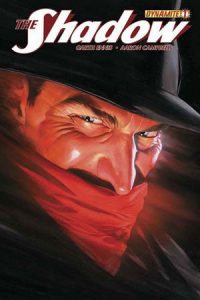 In 2012, Dynamite Entertainment began publishing a new Shadow comic book. Written by Garth Ennis, Chris Roberson, and others, the series was set in the 1930s. Alex Ross contributed many covers to the series, including this classic depiction of the character on the magazine’s first issue. The series ran until 2014, with a special issue published in 2015.
In 2012, Dynamite Entertainment began publishing a new Shadow comic book. Written by Garth Ennis, Chris Roberson, and others, the series was set in the 1930s. Alex Ross contributed many covers to the series, including this classic depiction of the character on the magazine’s first issue. The series ran until 2014, with a special issue published in 2015.
Dynamite also published a ten-issue miniseries in 2013-14. Written by Matt Wagner, it’s one of the best comic book versions of Walter Gibson’s creation. Wagner also wrote two other series featuring The Dark Knight, including THE DEATH OF MARGO LANE, published in 2016.
Although The Shadow has a lengthy history in the four-color medium, the character’s importance to the world of comic books is better reflected by its influence on the medium’s writers and artists. Many early creators of superhero comics were devoted readers of THE SHADOW MAGAZINE. These included Jerry Siegel, Jack Kirby, Stan Lee, Bill Finger, and Bob Kane.
In the first volume of THE STERANKO HISTORY OF COMICS, Batman co-creator Bill Finger admitted, “My first (Batman) script was a take-off on a Shadow story . . . . I patterned my style of writing Batman after the Shadow . . . . It was completely pulp style.” Pulp historians Will Murray and Anthony Tollin have surmised that Finger was talking about the Theodore Tinsley Shadow novel, “Partners in Peril.” It originally ran in the November 1, 1936 issue of THE SHADOW MAGAZINE.
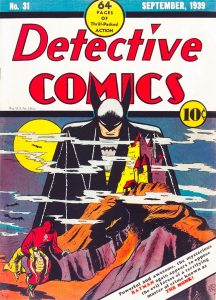 While artist Bob Kane cited Chester Gould’s Dick Tracy as one of his inspirations — particularly for his villains — Bill Finger, Batman’s writer, suggested, “The villains were patterned after those in the pulps, kind of bizarre and wild.” Doctor Death, the first of Batman’s master criminals, was introduced in DETECTIVE COMICS 29, dated July 1939. An earlier Doctor Death — a mad scientist who desired to remake the world after his own desires — was featured in a short-lived pulp magazine published by Dell. There is likewise evidence that Batman villains The Joker and Two-Face, as well as Police Commissioner James Gordon, may very well have had their origins in the pages of Street & Smith’s hero pulps.
While artist Bob Kane cited Chester Gould’s Dick Tracy as one of his inspirations — particularly for his villains — Bill Finger, Batman’s writer, suggested, “The villains were patterned after those in the pulps, kind of bizarre and wild.” Doctor Death, the first of Batman’s master criminals, was introduced in DETECTIVE COMICS 29, dated July 1939. An earlier Doctor Death — a mad scientist who desired to remake the world after his own desires — was featured in a short-lived pulp magazine published by Dell. There is likewise evidence that Batman villains The Joker and Two-Face, as well as Police Commissioner James Gordon, may very well have had their origins in the pages of Street & Smith’s hero pulps.
Although The Shadow certainly played the most influential role in the creation of the Batman saga, other pulp characters also inspired Bill Finger and Bob Kane.
Johnston McCulley’s Zorro — who debuted in a five-part serial beginning in the August 9, 1919 issue of ALL-STORY WEEKLY — wore a mask and black cape, had a hidden lair that he entered through a grandfather clock, and marked his adversaries. Dawson Clade, another McCulley character, was accused of a murder he did not commit. He dons a hood to get revenge against those who had framed him. In his origin story, a bat flies through a window and Clade comes up with his alter ego. He will become “The Bat.” Sound familiar?
Created by D. L. Champion and published by Ned Pines’ Standard Magazines, THE PHANTOM DETECTIVE ran until 1953, totaling 170 issues. Like Bruce Wayne, Richard Curtis Van Loan was a wealthy playboy who trained himself to be “the world’s greatest detective.” When The Phantom was needed, a red beacon on top of the local newspaper building was lit. DC editors Jack Schiff and Mort Weisinger later turned this into the Bat-Signal.
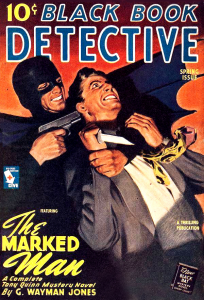 Another Standard character, The Black Bat, debuted in 1939, around the same time as The Batman. Notice the batlike wings on the cover to the Spring 1945 issue of BLACK BOOK DETECTIVE. It bears a marked resemblance to the cape of the early Batman. Although not depicted here, the Black Bat also sported spiked fins on the gloves he wore. Batman co-creator Bill Finger liked the look and suggested that Bob Kane add them to The Batman’s costume.
Another Standard character, The Black Bat, debuted in 1939, around the same time as The Batman. Notice the batlike wings on the cover to the Spring 1945 issue of BLACK BOOK DETECTIVE. It bears a marked resemblance to the cape of the early Batman. Although not depicted here, the Black Bat also sported spiked fins on the gloves he wore. Batman co-creator Bill Finger liked the look and suggested that Bob Kane add them to The Batman’s costume.
Considered the world’s first superhero, Doc Savage debuted a month after The Phantom Detective. Published by Street & Smith, the first issue of DOC SAVAGE MAGAZINE was dated March 1933. An adventurer possessing untold wealth, Clark Savage, Jr. was, like Batman, a master detective. Doc was never without his utility vest, a specially designed garment filled with all kinds of gadgets that he had invented. It served as the model for The Batman’s “utility belt.”
As you’ve seen, The Shadow has been inspiring all sorts of creators for nearly ninety years. However, Walter B. Gibson’s character is just one of many pulp characters that have inspired pop culture creators over the decades. PulpFest 2019 will focus on the many ways pulp fiction and pulp art have inspired and continue to inspire creators. We’re calling this year’s theme “Children of the Pulps and Other Stories,” an examination of the pervasive influence of pulp magazines on contemporary pop culture. We hope you’ll join us from August 15 – 18 at the beautiful DoubleTree by Hilton Hotel Pittsburgh – Cranberry in Mars, Pennsylvania.
(The first of our Shadow images is just shy of one-hundred years old. Painted by Modest Stein, the cover art for the April 1931 issue of THE SHADOW originally appeared on the October 1, 1919 issue of THE THRILL BOOK.
Unfortunately, the artist who painted THE INVISIBLE AVENGER movie poster is not known to us. However, George Rozen created the painting used as the cover for THE SHADOW #141, published by Sanctum Books in April 2019. The artwork was originally used on THE SHADOW DETECTIVE MONTHLY for June 1932, published by Street & Smith.
As mentioned above, Alex Ross painted the cover art for THE SHADOW #1, published by Dynamite Entertainment and dated April 2012.
Bob Kane’s Batman — as depicted on DETECTIVE COMICS #31, dated September 1939 — is remindful of the looming headshots found on Standard Magazine’s THE PHANTOM DETECTIVE. The Batarang and the Batgyro made their first appearances in this issue, featuring a villain known as The Monk.
The Black Bat was painted by Rafael de Soto for the Spring 1945 issue of BLACK BOOK DETECTIVE.
To learn more about the influence of The Shadow and other pulp heroes, please visit the PulpFest Instagram page.)

